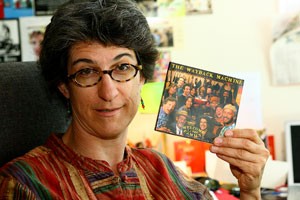Professor Profile
Hippies.
Some call them flower children. Others refer to them as drug users or stoners. People of younger generations think of ’69’s Woodstock, of peace and love, of an old, hidden picture of a parent decked out in beads and a flower garland.
But was that really what the hippie movement was about? And where are the bell-bottom wearing, peace-sign waving hippies of the ’60s today?
In a developing independent film, Beverly Seckinger, an associate professor and interim director of the UA’s School of Media Arts, will answer those questions.
“”The people I’m interested in are not the ones who had a little flirtation with the counterculture when they were 18 or 20 and then woke up one day and renounced it,”” Seckinger said. “”The people I’m interested in never renounced that time in their life or the importance of it.
“”I want to know more about their stories,”” she added. “”Like who they were then and how they are still that person, all these years later.””
Seckinger recently received a grant from the Arizona State Commission on the Arts to fund her film, which is projected to run about 30 minutes.
Seckinger began working on the film in 2006 while touring with the band The Wayback Machine, for which she still plays bass guitar.
The band plays music that attracts the dance scene started in the hippie movement – which is how she found out about some of the communities she features in her film.
One back-to-the-land community featured prominently in her film is in New Mexico.
“”A lot of people moved there in the mid-’70s,”” Seckinger said, “”in many cases because they had young kids or were about to have kids, and they wanted to raise their children in a very free environment.””
The ages of people profiled in the film range from young children to people in their 60s and 70s, she said.
Such communities often aren’t called “”communes”” anymore, Seckinger said, but “”intentional living communities.””
One man she interviewed told her that their lifestyle is based on “”living with intention.””
“”After these few years of working on this film, I would say that hippies of today are extremely mindful people,”” Seckinger said. “”They are thinking about how to live on this planet in such a way that they are not contributing to its demise.””
The notion of sustainability is a core hippie idea, she said.
“”Living lightly on the land, not acquiring a bunch of crap, making things yourself, growing your own food,”” Seckinger said. “”The whole environmental movement definitely got a big boost out of the intellectual context of that counterculture.””
People who refer to the ideas of green living and sustainability as “”trendy lifestyle choices”” are not seeing the bigger picture, Seckinger said. She said the ideas have become mainstreamed but should not be trivialized as a “”trend.””
“”There are a lot of values that characterize that culture that I really find laudable and useful and that we can learn from today,”” Seckinger said.
The current condition of San Francisco’s Haight Street – which she called the “”ground zero of hippiedom”” – is also highlighted in the documentary.
Haight Street is famous for the hundreds of thousands of hippies who gathered there during the summer of 1967.
Last summer, Seckinger took her video camera to the corner of Haight and Ashbury and interviewed pilgrims returning to the place that embodied their rebellious youth.
“”To look at these people, you would never necessarily guess that they were into the counterculture in the ’60s, because many of them look completely like a conservative American now,”” Seckinger said.
Seckinger asked people what they thought hippies were and why they had come to Haight Street. She also talked with shopkeepers and plans to revisit a storeowner this summer.
“”The woman came to San Francisco as a teenager in 1967 and never left,”” Seckinger said. “”She still talks with a total glow in her eye about how magical that time was.””
The term “”hippie”” originated from the “”beats”” – the counterculture forerunners to the hippies – to describe the new generation of the counterculture, she said.
It was not until media coverage of the “”summer of love,”” however, that the term and its stereotypes developed.
“”Stereotypes are based on something in reality, and it takes that thing and blows it up and distorts it,”” Seckinger said. “”There was some basis for all of those stereotypes, but they certainly don’t do justice at all to this substantial social movement.””
Seckinger has made other independent films in the past, including a documentary about the aftermath of the murder of Matthew Shepard in 1998 set in Seckinger’s hometown, Laramie, Wyo.









